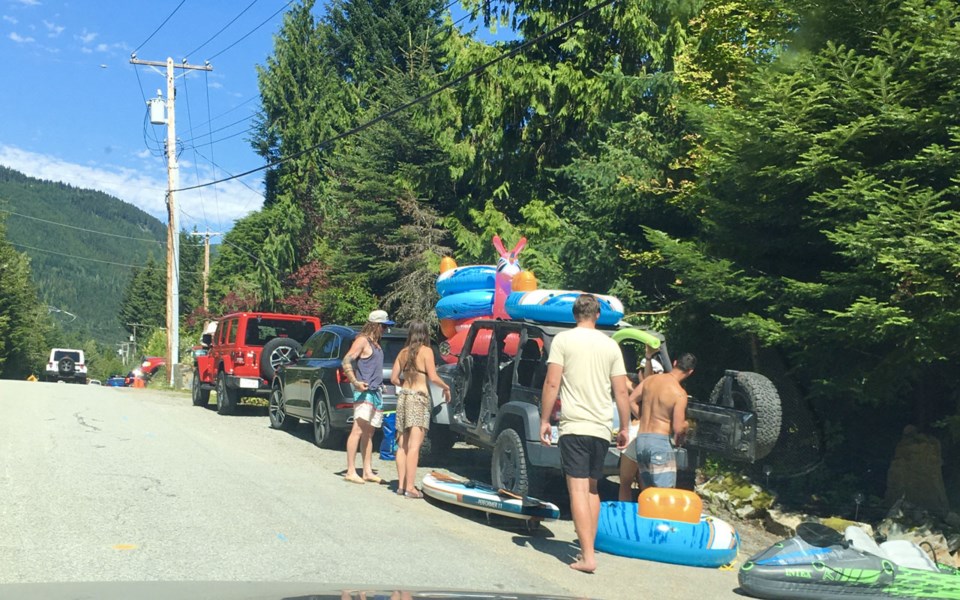There is a certain feeling of disconnect in the resort at the moment.
On the one hand, we are being chastised by provincial health officials and the premier over the alarming rise of COVID-19 cases as we settle firmly into Phase 3 of the re-opening plan for the province, while on the other hand, every local park, beach, bike trail, patio and eatery is packed. (However, it must be noted that more and more people are wearing masks in the village and trying to practise physical distancing if possible in the crowds. Alarming, though, a just-released Angus Reid poll found that one in five (18 per cent) respondents have expanded their social circles, don’t physically distance and are ambivalent towards hand-washing and mask-wearing. This last group also professes a clear dislike for the way public health officials and political leaders have handled the pandemic.)
And, we are not alone. I was lucky enough to get to Tofino last week, and Cox Bay looked like Waikiki Beach. It was crazy. In town, line-ups to get takeout were long and people were ratty, and forget heading out for dinner unless you had made reservations ahead of your vacation. And, yes, bring your own groceries.
Back here at home, looking at our overflowing parking lots and the busy stroll, it’s harder to imagine the economic impact COVID-19 is having on Whistler if you are not on the inside. But the dark underbelly of the terrible toll this pandemic is taking on tourism is lurking there, quietly eating away at small business, the accommodation sector, labour and more.
In a recent Letter to the Editor, Rick Antonson, the former president and CEO of Tourism Vancouver, predicted that it won’t be until 2023 that we will see a bounce back in the tourism sector, which until now had boasted about 19,300 working businesses offering 160,000 direct jobs generated through the $21.5 billion in visitor spending we enjoy (Pique, Aug. 13, “Immediate financial assistance needed to save B.C. tourism sector”).
Like our own tourism leaders, he has his eyes firmly fixed on the future and understands that as we head into shoulder season and a ski-season winter with the U.S. border closed, it is very likely that the tourism sector will face even greater peril than we saw during lockdown in Phase 1 of COVID-19. Let’s remember that it is estimated that B.C.’s tourism industry suffered a 69-per-cent decline compared to 2019.
He suggests an immediate financial injection of $680 million for working recovery grants for those in the sector through 2022. And he is not alone in his ideas.
Last month, the Canada West Ski Areas Association (CWSAA) proposed a mountain resort-funding program.
This “industry now generates $2 billion a year for the provincial economy and north of $121 million per year in tax revenue specific to the province,” CWSAA president and CEO Christopher Nicolson told Pique. The Association and other supporters want the province to set up a fund of at least $200 million to keep the sector alive until real recovery can begin.
There is little doubt that ski resorts are likely to get walloped this shoulder season and winter with no viable coronavirus vaccine in sight.
In an open letter to the community, Vail Resorts’ Rob Katz acknowledges that the very thing that will mean a successful winter—lots of people coming here from far and wide across Canada—is the same thing that could plunge us into another lockdown if COVID-19 comes back bigger and badder.
“Each one of our communities is a destination for visitors from countless other cities. This is our greatest strength, but it can also be a weakness. We cannot only look at the COVID-19 data in our local communities,” he wrote (Pique, July 30, “For the sake of winter, we must stay vigilant”).
Whistler leaders are at the table brainstorming and working on creative solutions—including Whistler Blackcomb, Tourism Whistler, the Whistler Chamber, the Resort Municipality of Whistler (RMOW), and the Hotel Association. They are all meeting regularly as part of the longstanding Economic Partnership Initiative—which has sort of resurrected itself in the face of the pandemic.
In recent days, we have seen Tourism Whistler share its reimagined marketing strategy, the RMOW is taking a second look at festivals to see how they can work in this new world of physical distancing and the Chamber has released its Moving Whistler Forward document to help its members (really, all of us) double down on how to stay resilient right now.
It has been almost overwhelming to see the support Whistler has enjoyed this summer as a destination.
But make no mistake as we head into the shoulder season and an uncertain winter season, if our local leaders in tourism, government and business aren’t shoulder to shoulder with the community to get us through, we could be devastated—and that includes my beloved Pique as well.




